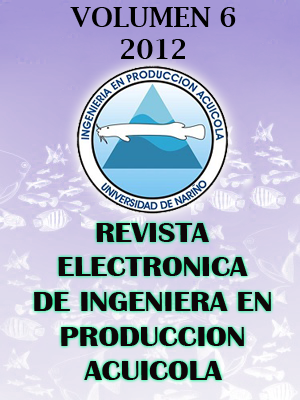ESTUDIO GONADAL DE LA SABALETA DE LA CUENCA DEL PATÍA (Brycon sp.) COMO INDICADOR DEL POTENCIAL ACUÍCOLA
Resumen
El valle geográfico del río Patía, presenta condiciones ecológicas particulares causadas por la contaminación, deforestación y sobrepesca, lo cual ha tenido un impacto negativo en las poblaciones de peces nativos como la sabaleta (Brycon sp). Los estudios de evaluación gonadal en los diferentes estadios de desarrollo de machos y hembras, reflejan la situación de las poblaciones en condiciones naturales y su interacción con el medio ambiente acuático modificado.
El grupo de Investigaciones Acuícolas (GIAC) del Programa de Ingeniería en Producción Acuícola de la Universidad de Nariño en colaboración con la Corporación Autónoma Regional de Nariño (CORPONARIÑO), evaluó el desarrollo gonadal de la sabaleta de la cuenca del río Patía como indicador del estado de vulnerabilidad y su aplicación en programa de cultivo en cautiverio. Para este efecto, se analizaron 26 ejemplares de diferentes pesos y tallas, obtenidos en varias estaciones de captura, ubicadas en los ríos Mayo y Juanambú, en su trayecto por los municipios de Taminango y Chachagüi. Se propuso como objetivos específicos de esta investigación:
- Calcular el factor de condición K de los ejemplares capturados.
- Caracterizar morfológicamente los ovarios en sus diferentes estadios de desarrollo. Estudiar morfológicamente los testículos en sus diferentes estadios de desarrollo
- Evaluar histológicamente los ovarios
- Caracterizar histológicamente los testículos
- Determinar e interpretar el índice gonadosomático
- Establecer y analizar el índice hepatosomático
Con base en los resultados obtenidos durante esta investigación, se puede concluir que las hembras y machos presentan una precocidad sexual para compensar la vulnerabilidad que registran las poblaciones naturales, debido al impacto negativo causado por la presión de pesca, la contaminación y la deforestación. Lo anterior implica que las entidades gubernamentales, deben Implementar programas de reproducción inducida con ejemplares obtenidos en diferentes estaciones de captura de los afluentes de la cuenca del río Patía que posean las mejores evaluaciones
fenotípicas y a partir de estos animales desarrollar planes de repoblamiento de la sabaleta (Brycon sp) en los distintos ríos de la cuenca del Patía.
Palabras claves: Cuenca del Patía, Sabaleta, Factor de condición (K), Desarrollo gonadal, índice gonadosomático (IGS), índice hepatosomático (IHS).
ABSTRACT
The geographic valley of the Patía River, has certain ecological conditions due pollution which is caused by industrial and domestic waste from the cities and towns of this region. This has had a negative impact on native fish populations of Sabaleta (Brycon sp). Therefore the gonadal evaluation reflects the state of fish population and the modification of the aquatic environment and how inadequate water conditions may affect the vulnerability of the ichthyic species.
The Aquaculture Research Group (GIAC) of Aquaculture Production Engineering Program of University of Nariño and collaboration with the Regional Corporation of Natural Resources (CORPONARIÑO) evaluated the gonadal development of sabaleta of Patia River Basin (Brycon sp) as an indicator of the status of vulnerable fish populations and their application in captive breeding program. With this purpose, 26 samples of fish were analyzed of different weights and sizes, obtained in several capture stations, located in the rivers Mayo and Juanambu in its path by the counties of Chachagüí and Taminango. The objectives of this investigation were:
- Determination of Condition factor K, gonadosomatic and hepatosomatic index.
- Macroscopic characterization of ovaries and testes at different stages of development.
- Histological characterization of ovaries and testes at different stages of development.
Based on the results obtained during this research, it can be concluded that females and males have a sexual precocity to compensate for the vulnerability that natural populations showed, due to the negative impact caused by fishing pressure, pollution and deforestation. This implies, that government entities, must implement induced breeding programs made up from fish samples collected, in different stations of capture from the various tributaries of the Patia river that have showed the best phenotypic assessments and at the same time, develop plans to repopulate the sabaleta (Brycon sp) in the Patia basin.
Key words: Patía Basin, Sabaleta, Condition Factor (K), Gonadal development, Gonadosomatic Index (GSI), Hepatosomatic Index (HSI).

